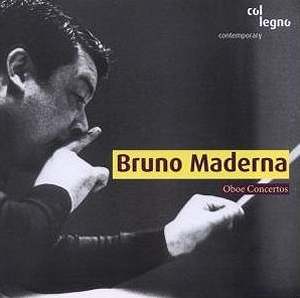There is always a duality
with Maderna's music. As a composer
directly involved with classes at Darmstadt
for an extended period (1954-67) his
serialist credentials are a central
feature of his work. While his music
is archetypically modernist there are
always the threads which bound him to
the neo-baroque conservatism of his
teacher Malipiero, and the warm expressiveness
which he inherited from his native Italy.
Modern yes: ugly or ungraceful; no.
One of his final compositions, the Concerto
for Oboe and Orchestra No.3, rubs
temporal shoulders with an opera, Satyricon,
also from 1973, in which Maderna indicted
modernism, ultimately rejecting the
abstract and returning to what might
be seen as ancient, or post-modern qualities
of lyricism and common comprehensibility.
Listening to some of the melodic lines
and gestures in the Concerto for
Oboe and Orchestra No.2 it isn't
a great leap to imagine such a change
in direction, even though in all of
these works there can be no claims of
instant approachability from the man
on the street.
Concerto for Oboe
and Chamber Ensemble No.1 has the most serial feel - notes being weighed
with Webernesque significance, growing
out of silence, the colour of instrumental
timbre developing from solo lines weaving
through the ensemble into a subtle tapestry
of multi-layered sound. Concerto
for Oboe and Orchestra No.2 opens with wind chords which
must have blown almost instantly on the Mediterranean wind into
Holland. I could mention a few Dutch composers who have made a
lifelong career from this mere 17 seconds by Maderna. Like the
first concerto there is a significant percussion section, but as
with all of the other instruments, these sounds are introduced as
detail - points or splashes of colour which can be as gentle as a
stellar curtain or have the impact of a gibbous moon rising with
disturbing suddenness over the desert. Shifting and restless, the
music demands concentrated attention, but as previously mentioned,
the solo oboe often lifts the ear beyond the semantic
complications in the orchestra into more lyrical realms. At one
point the soloist joins what almost sounds like a choir of oboes,
and the orchestra - understanding the oboist's message,
adopts and develops his soulful melodic
lines.
Opening with a reedy
overtone squeak from the solo oboe,
the Concerto for Oboe and Orchestra
No.3 extends the longing, almost nostalgic nature of
elements in the second concerto. Here the solo and orchestra often
explore beyond and return to a central sustained pedal note. Such
aural references, and a generally more transparent orchestration,
give this concerto a lighter feel - lighter in terms of weight,
or of light though a stained-glass window,
but not in terms of message. This is
the only concerto where the orchestra
is almost allowed a full 'tutti' sound at one or two
points - but again, everything is controlled and disciplined:
detail, colour and expressive line is the all-important factor - the roughness
of the brass almost appears like an
intruder into the private, intimate
world of the strings and soloist.
Having all of these
works on one disc in a way creates a
new work, a grand 'Symphony for Oboe and orchestra'. The unity of style in
Maderna's work and the contrast between
each piece allows each work to belong
to the other as a movement in a single
narrative on a Mahlerian scale. The
playing is exquisite, with Fabian Menzel's
oboe tone strong and penetrating where
required, but always beautifully intonated
and coloured, an instrument one can
listen to for a long time, and that's
not always true when it comes to oboes.
The live recordings are as good as noise-free,
and the consistency in engineering and
location helps make this set of recordings
to be greater than the sum of its parts.
Col Legno are to be applauded for bringing
these radio recordings to a greater
public, with a set of concertos very
much representative of one of the grand
masters from the last century.
Dominy Clements


